Garden Glimpses: Sprummer
No longer spring, but not quite summer – it’s Sprummer in the garden! Emerging as the last of the spring bulbs are fading, and the first of the summer perennials are starting to bud, Sprummer is that liminal time between seasons, populated florally by a few choice plants with roots in spring and tips in summer.
Sprummer is the time to sow seed, bed out annuals, and weed, weed, weed! Technically we’re not frost-free here until about May 15th, and despite the warming of global climate change, Mother Nature still likes to remind us of that fact from time to time. This year she sent temps plummeting all the way to 33 a couple days later, just a degree above freezing, but it’s been so dry that thankfully, there wasn’t enough moisture in the atmosphere to create frost. And that’s the only time you’ll hear me thanking the drought! With just a quarter inch of rain this month, I’ve had to start full-on watering by zone (rather than spot-watering with the bucket, as I see the need arise in particular plants), earlier than ever.
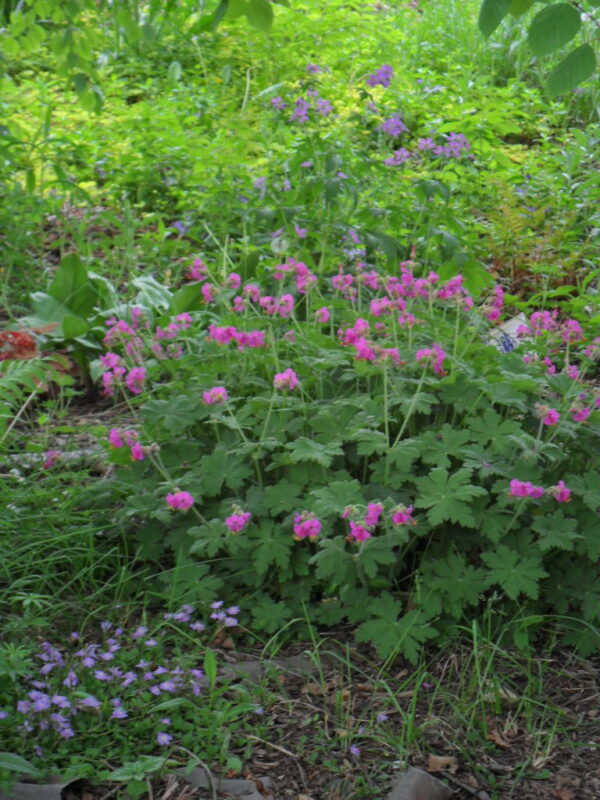
I had potted out some annual herbs before the frost warning, but was able to bring those inside, just in case. Yes, I’m back to pots for annual herbs, despite having plenty of room in the soil, because Vinnie, my resident mole/vole/gopher/unidentified small mammal, has developed a taste for parsley and basil, and ate out last year’s crop by the root before we’d gotten to midsummer. I guess he needed a salad course to go with all those crocus bulbs. I have seen no direct evidence of him this year so far (typically we cross paths, not to say swords, on a weekly basis), and hope he may have departed for Rodent Heaven, but I’m taking no chances.
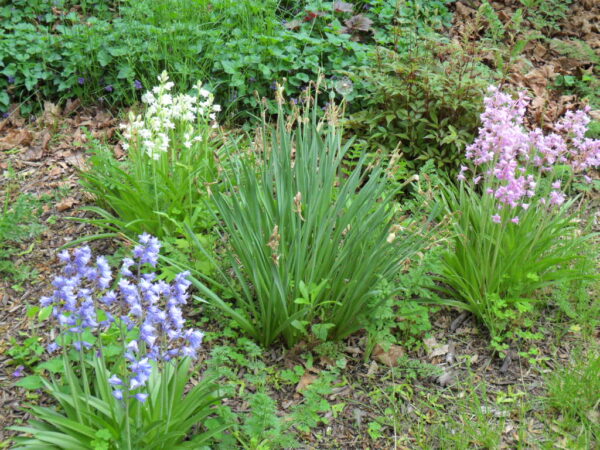
Sprummer kicks off with a pair of plants that are the last remnants of the spring bulb season. These are hyacinthoides hispanica, the Spanish bluebell, and ornithogalum umbellatum, the Star of Bethlehem. It’s nice to have these hang-overs from the riot of color and form that is my early season garden, a sort of stepping-down from that intensity to the more sedate summer greenery.
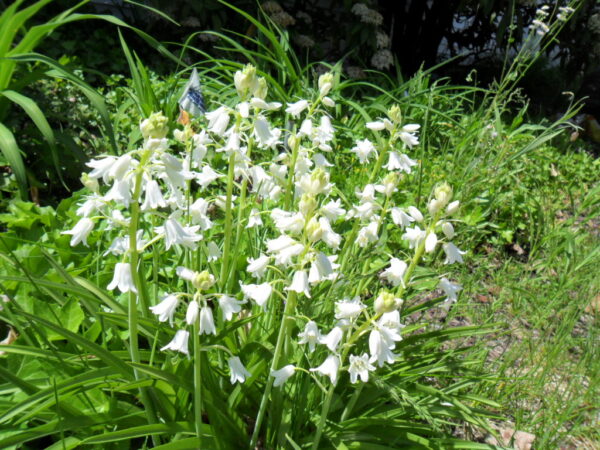
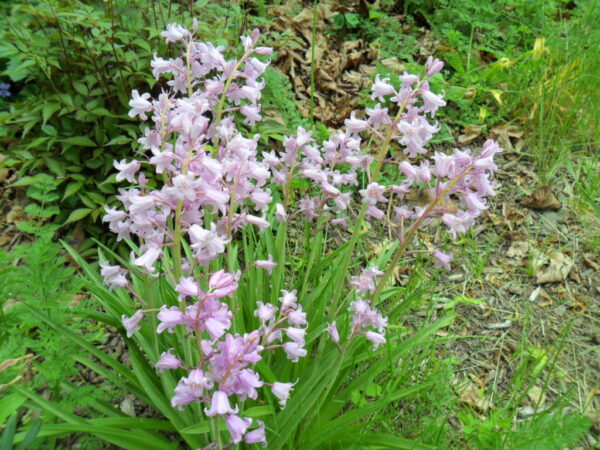
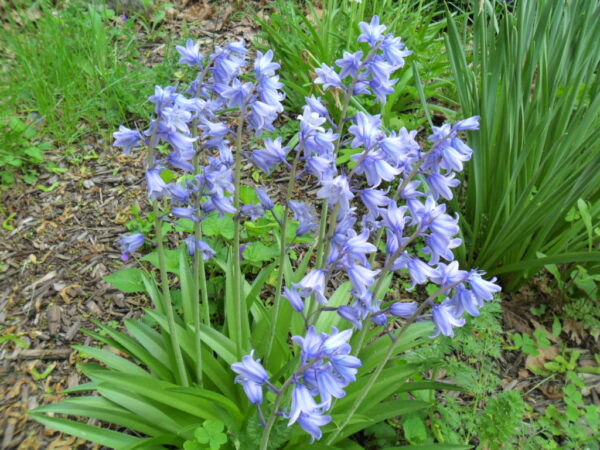
Spanish bluebells come into their own about mid-May, and depending on weather conditions, can linger for weeks. About 18” tall, covered over the top third of their stems with classic bell-shaped blossoms, they come in white, pink and blue varieties, and I have several plantings of each.

I’ve enjoyed wild native Star of Bethlehem since I was a child, finding it in woody, damp areas while out on walks with my parents. I brought home a patch of it once, from a small creek bed in a forested gully behind the house, and though it thrived for a few years, the increasing drought isn’t kind to this species, and it requires more water than nature gives it here. Sometimes I’ll still find a random ambassador of the native variety of this plant coming up in some corner of the yard, but I do much better with its cultivated cousin, which prospers well for me. Its look is virtually identical except that it’s a much larger, more vigorous plant, with somewhat bigger blooms.
There’s always a sense of sadness and nostalgia as these last bulbs fade away, but there are many more floral highlights to enjoy in the seasons ahead.
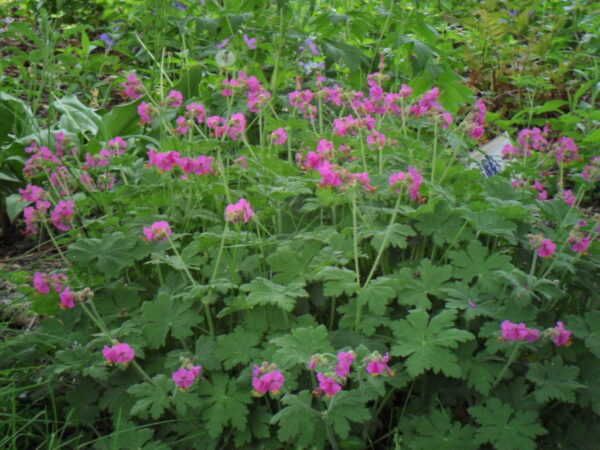
Queen of the shade garden right now is the hardy native geranium. I have four different varieties, two of which are early bloomers, and the other two mid-season. Mounds of blue violet and deep pink flowers dot the landscape beneath the birch, bright spots that look like beacons of color in the greenery. With the white woodruff and a bit of baby blue brunnera, plus the periwinkle blue flowers on the variegated green-and-lime vinca groundcover, it makes a lovely kaleidoscope of the shade garden.

In stark contrast to these cool tones is the vibrant tangerine geum, a great performer now in its fourth season here. A low mound of deeply cut leaves sends up tall aerial spikes of bloom that billow in the breeze. The blossoms resemble wild rose, simple ruffled petals in rings of five, double-layered, with mounded fuzzy centers.
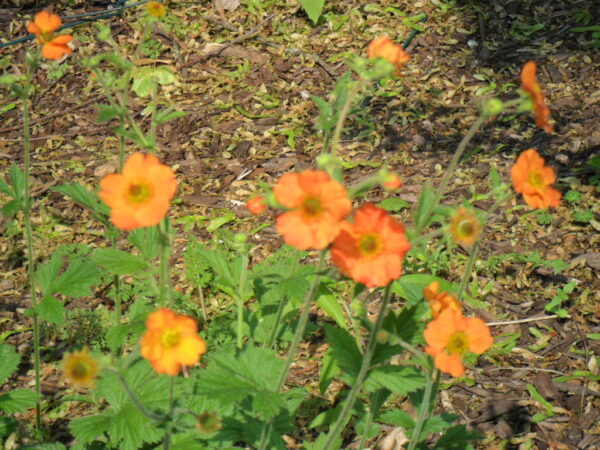
Euphorbia is another Sprummer shade stunner, with incandescent, almost neon compound flowers in chartreuse and yellow. Teeny bright gold blooms in clusters are nestled within small chartreuse bracts at the terminus of deep green stems and foliage. About eighteen inches tall, this euphorbia forms a compact ball shape that lends visual interest even when not in bloom.
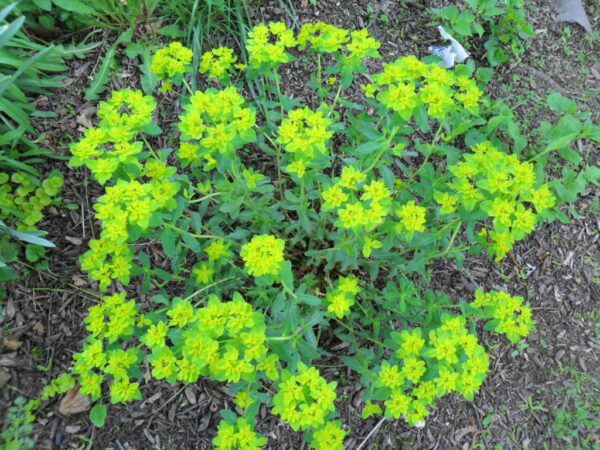
But the Big News in the shade is two first-time bloomers, both of which I’ve been waiting three years to see. One I planned – that’s the cornus alternifolia, the pagoda dogwood. I planted these two lovelies in the fall of 2020 as very small sticks, and watched them grow into attractive branched young trees, but up till now, their bloom has eluded me. My patience has paid off, however, with both trees favoring me with lovely rafts of fuzzy white flowers. While their leaves closely resemble other dogwoods with which you might be more familiar, their blossoms couldn’t be more different. No classic four-square petal structure here; rather, the pagoda dogwood sports clusters of miniscule fuzzy blossoms, more akin to those of a cranberry bush or lace cap hydrangea, or the frosty autumn offerings of boneset and white snakeroot.
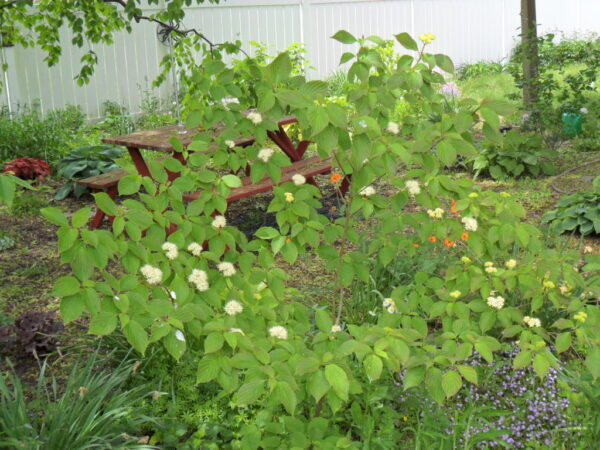
Pagoda dogwood gets its moniker from its successive layers of branches, larger circumferences beneath, tapering as the tree rises, with distinct gaps between layers, which resembles the structure of the Buddhist shrine of that name. It’s an elegant addition to the landscape, underplanted here beneath the maple and birch, with a view to increasing the shade cover for now and filling in for these aging monarchs in time.
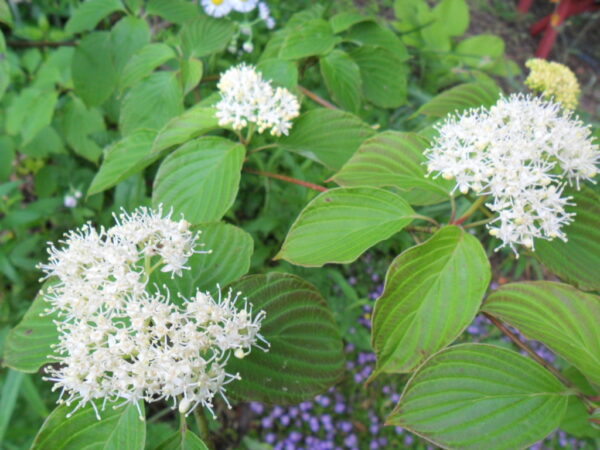
The unplanned resident I was unable to identify until this year, when it finally bloomed. About three years ago I began to see small seedlings popping up all over the yard, of a medium green, spear-leafed plant. Many of these were rooted out in the normal course of weeding, but I allowed some to thrive, intrigued by what they might be.
Their ubiquity puzzled me somewhat. With nothing like it in the yard or the surrounding area, how could it have come to be here, and so pervasively? It couldn’t have spread by root, bulb or rhizome, which argued for a seed or fruit as its source, conveyed to the yard by bird, beast or breeze. And that meant it had to bloom, which might be lovely – I just had to wait to see. I tried to identify it on PlantFinder, but its leaves were nondescript enough to yield a plethora of results, all with low percentage of accuracy. So I waited it out (admittedly, with less patience than I had for the known quantity of the pagoda dogwoods), and finally this spring the eldest of these interlopers, now a good four feet tall, bloomed, and I was able to positively identify it as a species of bush honeysuckle.

This is good news and bad. With an attractive white-and-yellow, almost snapdragon-like blossom and a lovely scent, honeysuckle makes a bold show in Sprummer, but is nevertheless an invasive spreader. I’ve already started the process, now that I’m sure what I’m dealing with, of rooting out several less mature plants and curtailing new seedlings as they emerge, but I’ll keep perhaps half a dozen of these scattered throughout, in areas where nothing else wants to grow. Their growing habit is so vigorous, I’m thinking about trying my hand at topiary with a couple, aggressively trimming them into some as-yet-undetermined shape. Green tombstones, anyone?
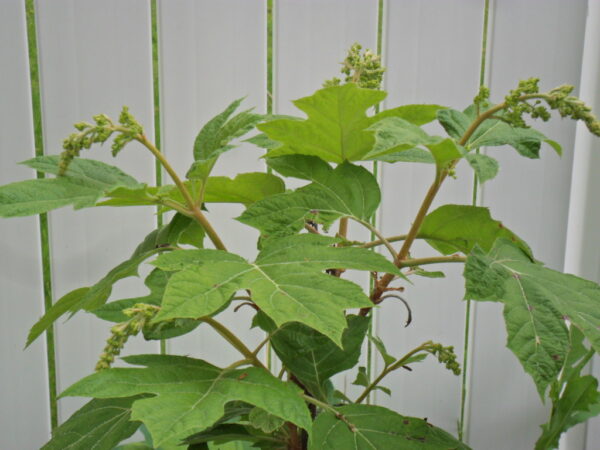
Warming up in the bullpen for summer bloom are my five marvelous hydrangeas, four oakleaf varieties and an arborescens. Three of the oakleafs, Snowflake, Pee Wee and Queen of Hearts, have been favoring me with blooms for two years now, as has the Annabelle arborescens, and all are ramping up their floral capacity as they mature. The fourth oakleaf, Alice, has been late to the party. Although the largest and best-established plant by far, last year she thrust up just a single mutant blossom, which withered and died before opening fully. But Alice appears to be making up for lost time, with no less than ten blooms a-bud. I can’t wait for the show!
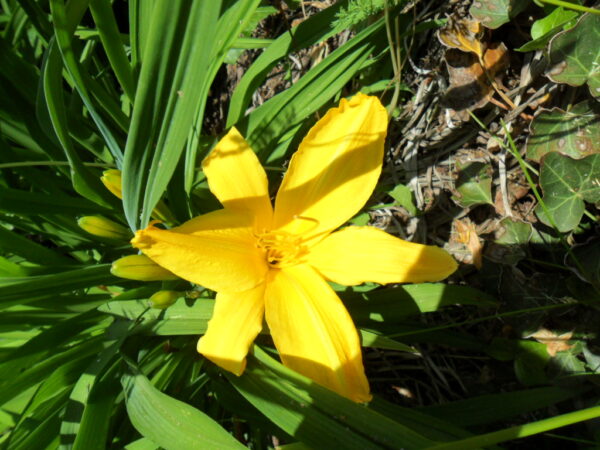
So much for the shade garden, but things are heating up in full sun, too. I’ve already had a couple of blooms, well out of season, on my superlative Buttered Popcorn daylily. This variety typically blooms earliest of the 45 I have cultivated, but never this early! It’s a good three weeks ahead of schedule, but I’m not complaining, simply enjoying its vibrant yellow blossoms, which really do match the color of that fake liquid butter on movie popcorn.
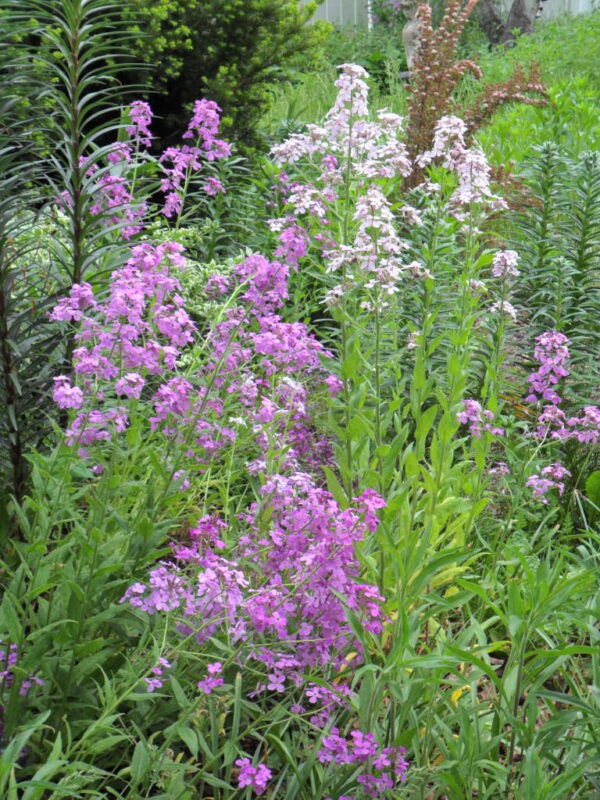
There are plenty of other plants that should bloom now, and are. Rocket comes to mind immediately. A common native in our area, rocket is that ubiquitous country roadside weed that fills gullies and embankments with broad colonies of vivid spires of clustered blossoms in shades from white and pale pink-violet to medium purple. Completely unremarked the remainder of the season, in Sprummer rocket boldly shows its stuff in eye-catching fashion, often creating drifts of color in the landscape. Not a true perennial, rocket is nevertheless a reliable self-sower, though you can’t always specify exactly where its descendants will emerge next. Its tall, four-foot habit with multiple branches of candelabra-like structure makes it a standout in the garden, wherever it chooses to grace me with its presence.
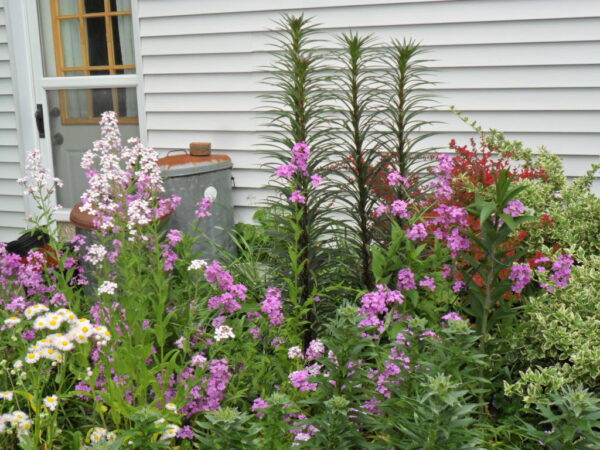
If rocket is in bloom, then English daisy and Siberian iris can’t be far behind. And here they come, right on schedule, with pops of yellow-centered white and deepest blue ringing the top of the sandmound. Last year’s drought and this winter’s polar vortex haven’t been kind to these species, which have decreased overall by about a third, but they still offer plenty of color to liven the Sprummer garden.
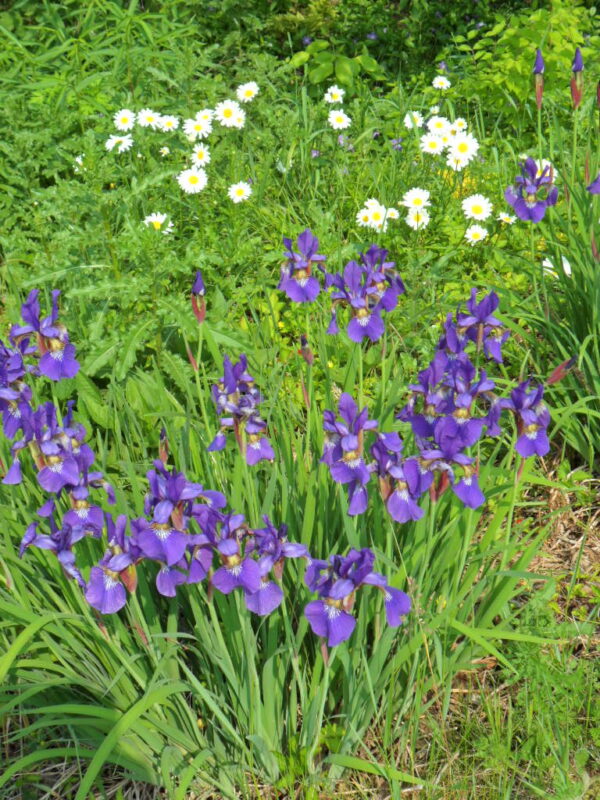

There are a few more early-blooming varieties of summer perennials, not to mention some herbs, which are in full flower now. Salvia officinalis, the common culinary sage, surprised me this year with an impressive array of huge spikes of purple blossoms, also edible. I have grown sage in many years and many guises, but I have never had a culinary sage bloom before. After looking half-dead in late winter, this herb has rebounded amazingly, almost tripling in size before sending up tall, 3-foot stems dotted with medium purple, snapdragon-like blooms.
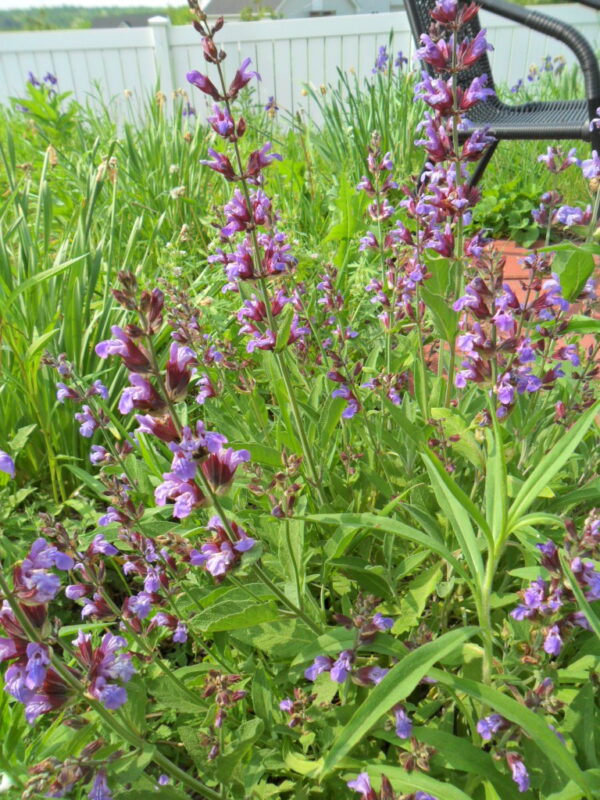
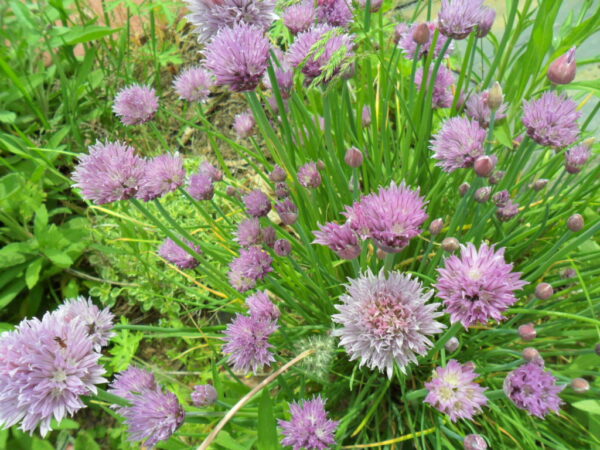

In like manner the thymus vulgaris, common thyme, has vastly overspread its bounds from last season, and is covered in masses of tiny pink-violet blossoms, offset by the tall stalks of culinary chives nearby, tipped with pink-purple rounds that clearly betray its relation to the allium/onion family. It’s a harmonious cool color pallet highlighted by the vibrant golden yellow blooms of a baptisia in the background, only a few feet away. Just in its second year, baptisia isn’t as well established, but has put on a brave showing this Sprummer, and in due course I hope it will rival its neighbors.

The pink salvia is also at peak as June looms, a sturdier, more densely packed relative of the culinary sage. Spires of medium pink blooms in close profusion really light up its corner of the sandmound, otherwise largely bereft of bloom at this time. It’s fairly drought tolerant, and will give a nice rebloom in midsummer if sheared back after its first effort.
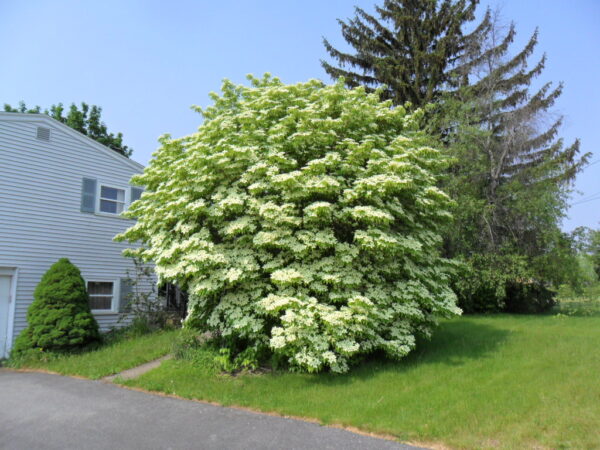
In many ways, however, shrubs and trees are the highlights of the season. We’ve already discussed the pagoda dogwood, but not its Chinese cousin, cornus kousa, which blooms a bit later. Unlike my pagodas, the Chinese dogwood is well established here, having been planted by my parents some 35 years ago. It has grown into an impressive tree, especially after my father passed, who used to keep it carefully trimmed into a ball shape yearly. I have a more relaxed, “live and let live” attitude to plants, and rarely prune except to remove dead or diseased areas, or when its size makes it impassable. Kousa is even later to bloom than pagoda, ordinarily not until mid-late June, but it’s in full swing now as May ends, and absolutely covered in blossoms. These emerge a pale greenish white, then blanch to creamy white as the flowers mature, and will yield dimpled pink-red fruits come late summer, with vibrant autumn color to follow, in fire tones of red, orange and yellow. The bloom form is very similar to standard dogwoods, four petals in square with a small yellow-green center that becomes the fruit.
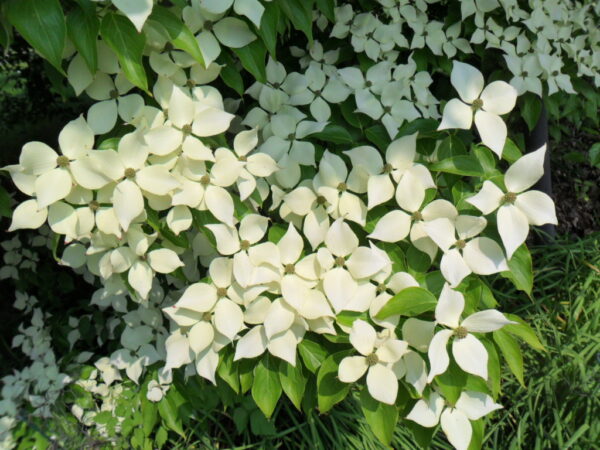
Other heirloom blooming shrubs on the property include leatherleaf viburnum, spirea Bridal Wreath, mock orange and a red-burgundy weigela. As with the kousa, these plants used to be restricted by my father’s pruning, but seem to enjoy having the run of their spaces.
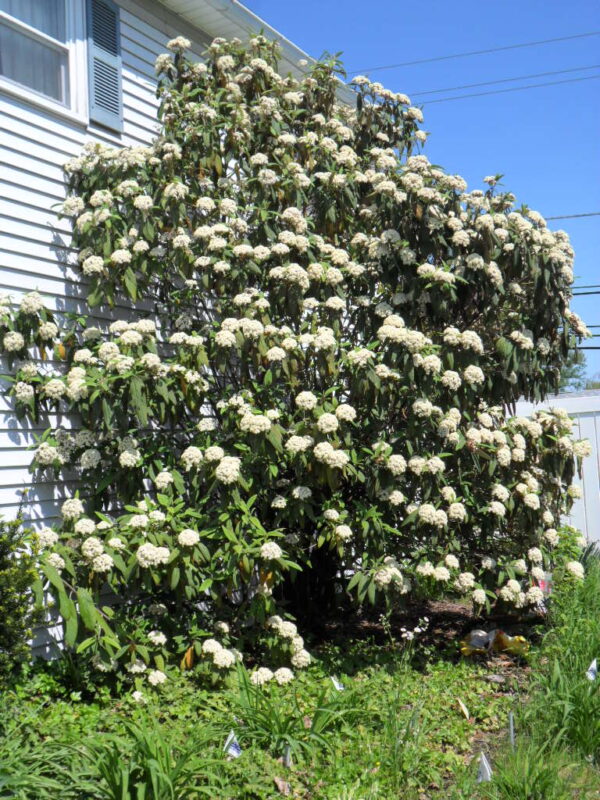
The viburnum is at least twice its former height, in just four years of benign neglect, but has reached its zenith of roughly 20 feet. And just in time, as it’s about to scrape the second-floor spouting. With a blossom similar to the pagoda dogwood, compact, rounded clusters of miniscule white flowers with yellow anthers extending above, it provides quite a show as May deepens into June.
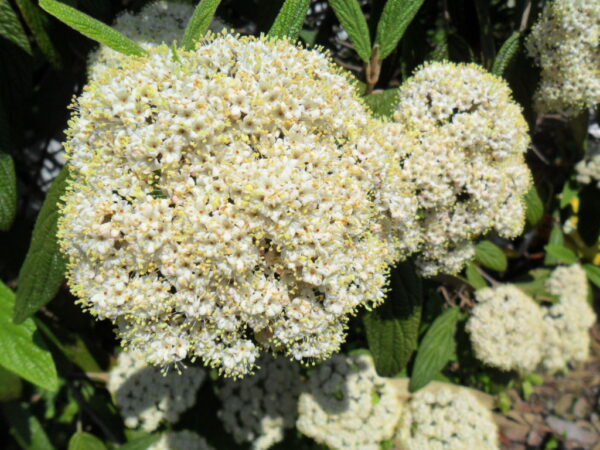
But for white-flowering shrubs, all must give way to the Bridal Wreath, with its graceful, arching branches smothered in groups of blossoms all along the stem, looking like nothing so much as a still-life capture of a frothing fountain. This is one plant I do have to trim, as it would otherwise prevent access to the AC unit for servicing, but I wait until after its bloom, cut it hard to retain the shape, and then watch as this spirea unabashedly fills in again over the remainder of the season, ready for another beautiful spring.
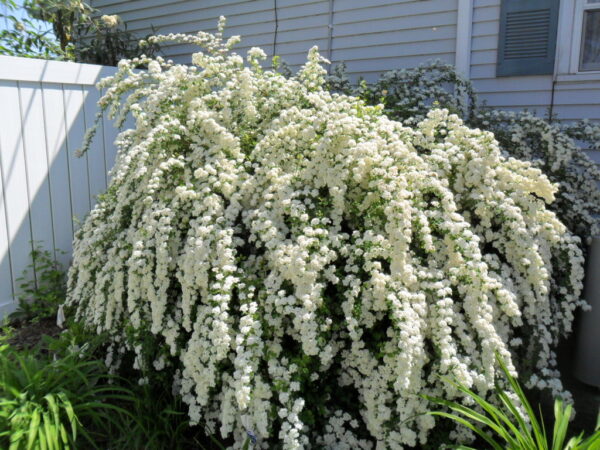
The weigela and the mock orange didn’t fare so well with the drought last year; both have large dead sections that I have yet to remove, and subsequently, less bloom. The mock orange floral output is also restricted by too much shade from nearby lilacs and the overhanging birch, but there is still plenty to cut for indoor bouquets.
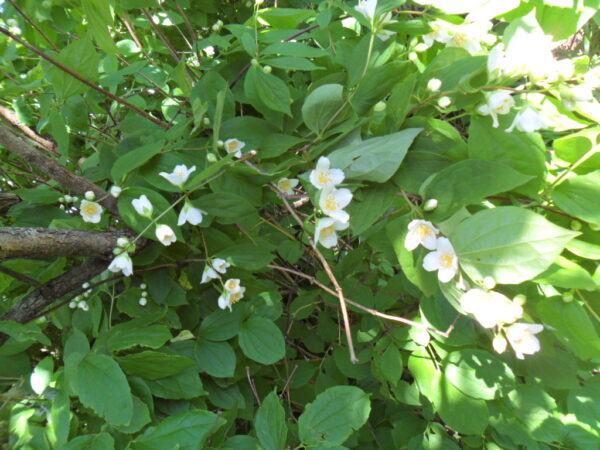
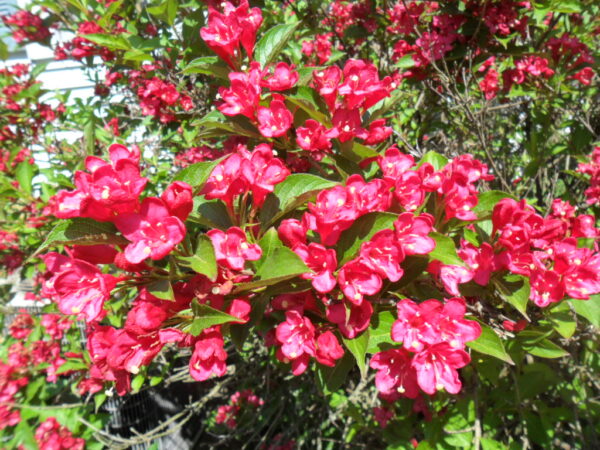
One shrub I chose myself is the physocarpus “Sweet Cherry Tea.” With dusty rose foliage all season long, redder as the new growth emerges, and charming pink spirea-like flower clusters in late spring, this medium-sized shrub with an arching habit, commonly known as Ninebark, makes an exceptional accent piece in the garden. It’s thriving in its third season here, more than doubled in size.
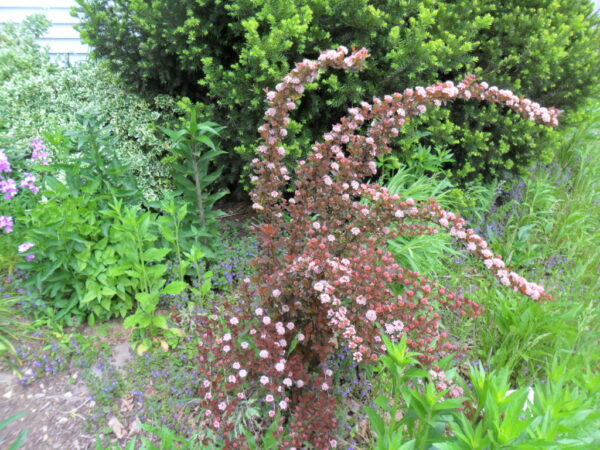

Another unexpected guest is robinea pseudoacacia, the black locust tree. A member of the pea family, this quick-growing native puts on yards of growth per season. One unexpectedly came up just beneath the failing birch clump, so I’ve let it thrive, as a replacement for that, once it finally gives up the ghost. Yes, it’s far too close to the fence for comfort, but I figure, even at its current growth rate, that’s a problem for the next owner of this property! It’s just two years old, well over 10 feet tall, and bloomed this year, with dangling cascades of white clusters of flowers that betray its pea family heritage.

Technically, we’ve never had black locust on this property, but for several decades early on, we did have a pair of globe locust, which yields a snazzy bright pink flower. This was grafted onto native black locust stock by my grandfather, however, and for many years after its demise we found small black locust seedlings coming up in the lawn from the former tree’s roots. They were simply mowed down, but with the loss of the lawn came the end of the mowing, and I can only assume this new sapling is yet another scion of that long-gone locust, whose resilient roots have not quite turned to dust.
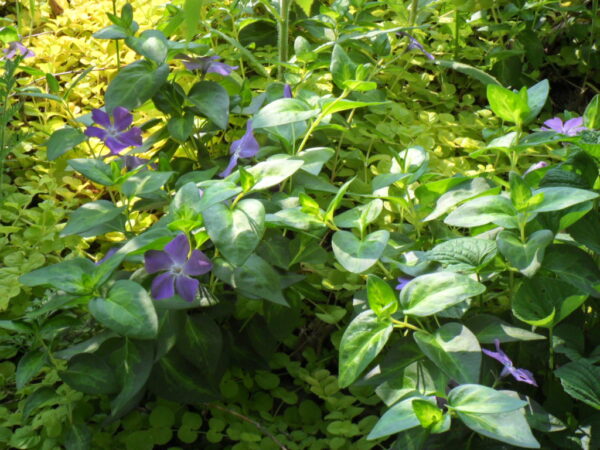
My grandmother’s backyard was shaded by several hoary, old black locusts, which invariably bloomed over the Memorial Day weekend, sending showers of spent blossoms onto our picnic foods, so having one in flower again on this property brings back those fond childhood memories.
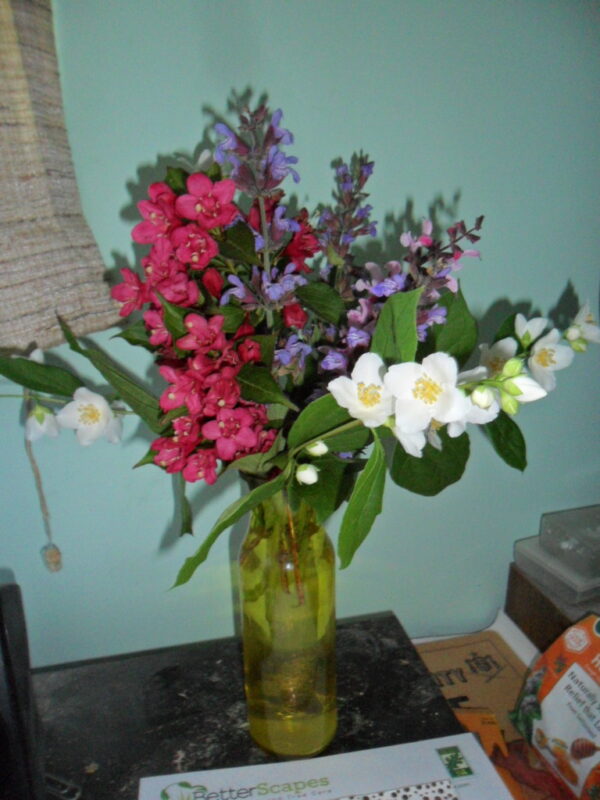
Like all seasons, Sprummer is fleeting, but a joy to behold while it lasts. It provides that last, lingering taste of spring gone by, and the promise of summer yet to be. As such, it just might be the most bittersweet of all.


4 comments, add yours.
Irmgard Dering
Your flower videos always make my Day! Thank you!
Try Juicy Fruit Gum or Coffee Grounds for your moles, etc…
Laurien
Enjoyed the photos so much, and was especially impressed by the Chinese dogwood! I see my weeds are really coming up too along with everything else! Looking forward to your summer roundup! Thanks Alex!
Greg B.
Great photos, Alex, and I appreciate the gardening information. Would your climate allow you to grow bigleaf (macrophylla) hydrangeas? I think they’re sturdier than American (arborescens) hydrangeas and easier to grow than oakleafs. I’ve got a Cornus hongkongensis that looks a lot like a kousa dogwood at this time of year, but it’s almost evergreen in my Zone 9 climate in Japan. BTW, the fruits of both C. kousa and C. hongkongensis are edible, but you have to be quick to beat the birds.
Alexa
Love the garden updates! Quite an abundance of blossoms already. I had honey suckle bushes in front of my high school and enjoyed the sudden waft of fragrance every morning. I’ll try to find one in my new town, and am looking forward to perfume-y linden blossoms on my street in July.